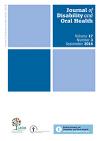Journal of Disability and Oral Health

- Cover Date:
- September 2016
- Print ISSN:
- 1470-8558
- Vol:
- 17
- Issue:
- 3
Correspondence between dentists and medical practitioners: a pilot audit
Castle-Burrows et al.: Correspondence between dentists and medical practitioners
Abstract
Objectives: To establish the reasons why dentists write to medical practitioners, assess the clinical usefulness of
responses, consider how the process can be improved and the implications for training dentists in the dental
management of patients with complex medical conditions. Methodology: 102 letters to medical practitioners were submitted for retrospective analysis over a 6-month period in 2012. Data were collected on: information requested from and received from the medical practitioner, the level of the patient’s medical complexity using the American Society of Anaesthesiologists (ASA) scale and the management implications for dental treatment. Results: 44 letters requested advice on dental management issues, such as suitability for treatment in primary dental care or for the use of sedation; 40 requested information regarding the patient’s medical history. There were also requests for test results, assessment of disease severity, lists of current medications, and assessment of bleeding risk. Additionally, there were 14 letters written providing information to medical practitioners. A number of letters requested more than one piece of information. Eighteen (17.6%) letters written received no reply, and a further 9 (8.8%) replies were assessed as being of no clinical use as they either were unable to give the information requested or gave advice which conflicted with existing guidelines. Only 46 (45.1%) letters received a reply which fully addressed the questions raised by the dentist.
Conclusions: Letters written between dentists and medical practitioners often fail to provide the information required, either because no reply is received, or the reply fails to address the concerns of the dentist. The authors suggest a need to improve the questions that are asked within dentists’ letters to medical practitioners by making them more appropriate and specific. The use of existing tools and guidelines may also support dentists in assessing medical risk and knowing when to seek the advice of a specialist in Special Care Dentistry rather than deferring the decision to the medical practitioner.
Key words: Correspondence, medical practitioner, dental management
Doi: 10.443/JDOH/Castle-Burrows_06
- Article Price
- £15.00
- Institution Article Price
- £
- Page Start
- 127
- Page End
- 132
- Authors
- C L Castle-Burrows, J Parekh, N Ransford
Articles from this issue
- Title
- Pg. Start
- Pg. End
- Is there an association between oral health and the incidence of pneumonia in adults with a neuro-disability who are Percutaneous Endoscopic Gastrostomy (PEG) fed?
- 112
- 120
